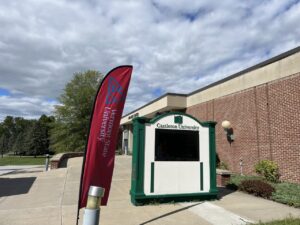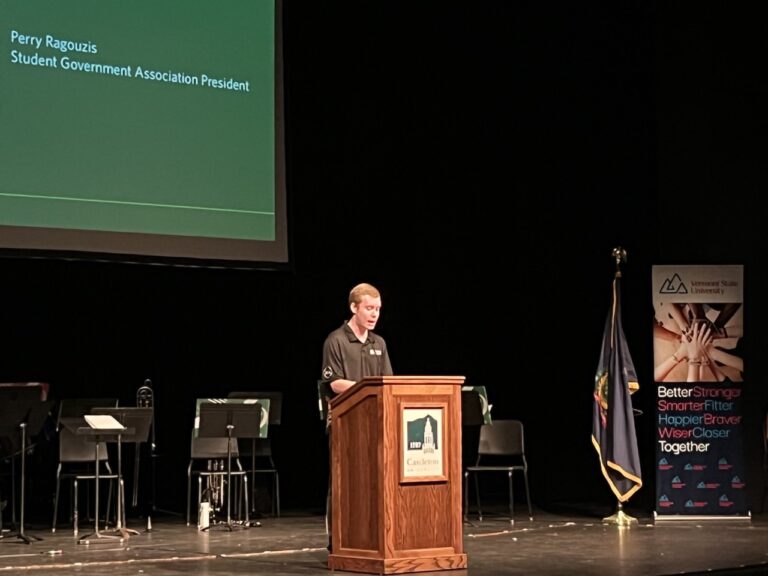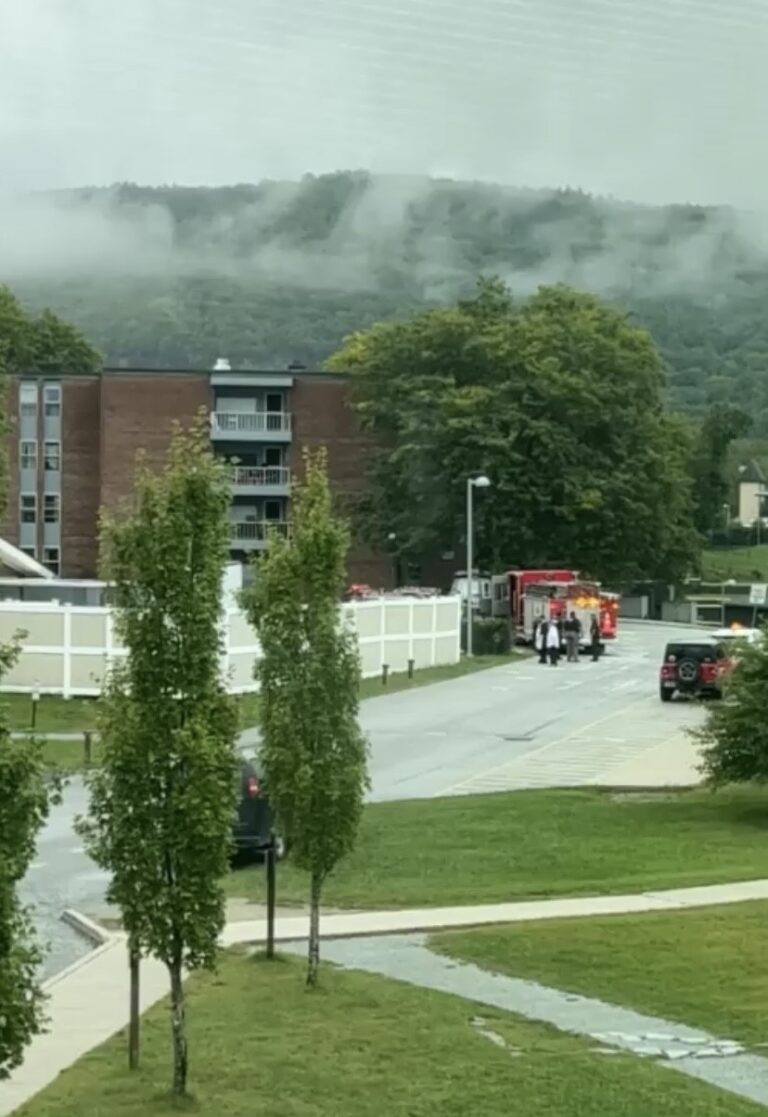Mixed reviews for rebrand

On May 17, administrators and faculty from across the Vermont State Colleges System gathered via Zoom to unveil the official brand launch for the rising Vermont State University. Now, almost four months later, Castleton University students, faculty and alumni still have mixed feelings about how this change will impact the new university.
The broadcast, which featured statements from faculty, VSCS representatives and President Parwinder Grewal, provided the first look at the now controversial, VTSU logo.
Featuring a design of three teal triangles intersecting beside a pinkish moniker, administrators have celebrated the logo as a way for the new university to stand out and support the unique hybrid approach the university is taking.
“We’re the Green Mountain State, and we’re a small state, but the consequence is that everyone has green mountain everything. So, I really like that it was kind of a twist on the green mountains. I like that it is innovative and different,” Chancellor Sophie Zdatny said. “It’s been receiving a really positive reaction, particularly from prospective students, but I’ve also heard from legislators, community members, etc.”
A brand is born
The rebranding effort, which first began work a year prior to its release, was overseen by a dedicated Brand Identity Team headed by Sylvia Plumb, the new director of university marketing and communications. The team worked in collaboration with the North Carolina-based company, Vision Point Marketing, and Burlington’s Solidarity of Unbridled Labor to complete the project.
In total, the entire rebranding project cost roughly $340,000 according to a figure provided by Zdatny from the time of the brand launch. Zdatny said the rebranding work was all done on budget and represented a small portion of the $20 million received from state legislature to fund the transformation effort in the early stages of the merger.
“I just want to emphasize that (number) is not just for the name or for the logo, it’s for the whole package — all the work that was undertaken. And some of that work was also used in developing the mission and vision for the new university,” Zdatny said. “(That number) represented a lot of work.”
Vision Point, according to Zdatny, conducted thorough reviews and audits of each institution, over 30 listening tours with stakeholders, competitor and peer research and a brand workshop, before developing a brand perception story from the feedback of some 3,500 individuals after which production on the logo began. Solidarity of Unbridled Labor later joined the effort to finalize the logo design.
“We asked for feedback from both the internal and external audiences in the strategy phase of the new brand creation, not in the logo phase. This is best practice – to listen to what the ‘market perception’ is in addition to hearing the current internal audiences’ hopes and dreams during strategy. By the time we move to creative work, it’s challenging to make everyone happy, as we’ve seen here, but being strategically sound is of utmost importance and this logo represents what we are building well,” Plumb stated in an email.
Castleton community weighs in
According to a chart provided via email by Plumb, of the 3,000-plus individuals who provided feedback throughout the branding process, 246 of those were Castleton students, 543 were Castleton alumni and 169 were Castleton faculty.
Despite this, some Castleton community members have expressed a feeling of exclusion from undertaking, particularly with the logo. Larry Courcelle, Castleton University Alumni Association Vice President, has been vocal about his opinions on the merger since the very beginning, and stressed that he and the Board of Directors were not consulted throughout the transformation process. He added that the logo process was no different.
“My first impression when I saw (it) on a commercial or wherever I saw it first was, ‘That’s it? That’s the best you can do? Triangles?’ I was kind of a little bit in shock. I understand the symbolism of the triangles, but I feel that they fell short of a logo for an institution of higher learning,” he said.
Junior Joseph Kinney was also taken aback by the brand reveal, adding that he wished students were more involved in the process.
“We’re all students. We all have a stake in this,” Kinney said. “They should have had graphic design students (from the universities) make logos and then go off that. I feel like we have this untapped resource.”
Castleton Content Lab President Richmond Rathbun, a senior, said that she also wished she and her fellow students could have had the opportunity to feel involved with the branding effort.
“I don’t think any of our colleges really enjoy having to do this, but it still (could’ve) built a sense of the community — even just consulting,” she said. “In a community, the ability to describe themselves and make something that stands for them, I think you’d get a better logo and a better understanding of how you want to come across.”
While Plumb acknowledged in an email that the universities’ graphic arts programs were indeed not consulted on the logo design, Zdatny clarified that the choice of an expert external company for the project was to ensure the logo received the best possible outcome for the university moving forward.
And while last year’s Content Lab President Jason Trahan, now a CU alum, agreed with Rathbun in a desire to be a part of the process, both acknowledged they enjoyed the design and symbolism of the mountains. However, Trahan also feels it’s still too early to say how the logo will sit with prospective and future VTSU students.
“I think the branding decision for this change is very, very important, but I think it will play a bigger role once all the commotion of the merger dies down and people start to find their place again. Right now, everything is so fresh and it’s hard to deny lots of our biases and preconceived notions towards the merger itself,” he said.
Since the release of the logo, Zdatny and Plumb both reported receiving an abundance of positive feedback, particularly from prospective students and their families.
Plumb shared some of the comments via email that the Branding Team heard throughout a series of events held over the summer to advertise the brand, including “Vermont State University sounds better any way,” “Oh man, I graduated from Johnson State years ago. I wish they had this when I was there,” “This rebrand seems to be the one that will stick” and “My son really wants to go to school in Vermont but has found limited opportunities … I think this would be perfect for him,” among many others.
Though Zdatny said she’s only received a couple of negative comments on the logo directed toward her, she acknowledged that change is difficult and hopes others see how future students are already reacting to the branding.
“Obviously, any time you do a name change or a logo change or anything there’s absolutely no way you’re going to get everybody on board. From my perspective, the most important thing was how does it resonate with prospective students, their families, the communities we’re in, etc., but I fully understand alumni not liking it — it’s not what it was when they were there. At the end of the day, it’s really what appeals to students,” Zdatny said.
And some current students are already getting on board with the logo.
“I think (the logo) will be way to recognize the schools. And being in Vermont, I think it would be a good identifier to that,” sophomore Amelia Harrison said. “I think it will be a positive identifier of the schools.”
Sophomore Hayden Hull said that while he may not love every aspect of the logo, he thinks it will deliver some positive messages to students as the merger moves forward.
“On the positive side, I’m sure people will look at (the logo) and see things like ‘this is no-nonsense college, they are simple, they are straightforward, they are to the point.,” he said.
Plumb wrote that she is excited to see the continued response from students, both current and prospective, on the new university branding and reiterated the important role community members have played throughout the branding process.
“In all the work we do to move towards transformation and unification, the voice of students, alumni, faculty, staff and business and community members as well as Vermont’s legislators has been a critical component of our work,” Plumb wrote. “What we hope is that our communities will realize that we are better together. Our logo is one symbol of that togetherness.”








